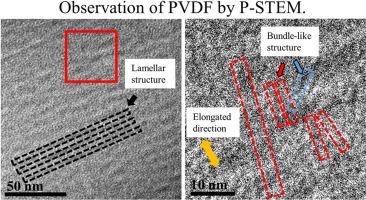利用相板扫描透射电子显微镜观察聚偏氟乙烯的层状结构
IF 4.1
2区 化学
Q2 POLYMER SCIENCE
引用次数: 0
摘要
聚偏氟乙烯(PVDF)是一种晶体聚合物,以其优异的压电性能、柔韧性、耐化学性、耐热性和机械强度而闻名。PVDF表现出晶体多晶性,有五种晶体结构。其中,β型结构因其优越的压电性能而备受关注;然而,其压电机制的细节尚不清楚。在纳米尺度上对聚偏氟乙烯的结构进行评价是阐明其压电机理的必要条件。在这项研究中,作为阐明其压电特性的第一步,我们使用相板扫描透射电子显微镜(P-STEM)观察热拉长PVDF。P-STEM在检测由轻元素组成的材料时特别有效。我们成功地可视化了层状结构,其特征是晶体和非晶态区域的分层排列。层状结构的周期约为7 nm,这与小角x射线散射的结果吻合较好。此外,高倍P-STEM图像显示,取向于延伸方向的束状结构可能是结晶区。这一结果表明,P-STEM提供了有关PVDF聚合物链取向的详细局部信息。本文章由计算机程序翻译,如有差异,请以英文原文为准。


Visualization of the lamellar structure of polyvinylidene fluoride using phase-plate scanning transmission electron microscopy
Polyvinylidene fluoride (PVDF) is a crystalline polymer well-known for its excellent piezoelectric properties, flexibility, chemical resistance, heat resistance, and mechanical strength. PVDF exhibits crystal polymorphisms, with five reported crystal structures. Among these, the β-type structure has attracted much interest due to its superior piezoelectric properties; however, the details of its piezoelectric mechanism remain unclear. It is essential to evaluate the structure of PVDF at the nanoscale to elucidate its piezoelectric mechanism. In this study, as a first step toward elucidating its piezoelectric properties, we employed phase-plate scanning transmission electron microscopy (P-STEM) to observe heat-elongated PVDF. P-STEM is particularly effective in examining materials composed of light elements. We successfully visualized the lamellar structure, which was characterized by a layered arrangement of crystalline and amorphous regions. The period of the lamellar structure was approximately 7 nm, which was in good agreement with the results of small-angle X-ray scattering studies. In addition, high-magnification P-STEM images revealed that bundle-like structures oriented in the elongation direction were likely crystalline regions. This result indicates that P-STEM provides detailed local information regarding the orientation of the PVDF polymer chains.
求助全文
通过发布文献求助,成功后即可免费获取论文全文。
去求助
来源期刊

Polymer
化学-高分子科学
CiteScore
7.90
自引率
8.70%
发文量
959
审稿时长
32 days
期刊介绍:
Polymer is an interdisciplinary journal dedicated to publishing innovative and significant advances in Polymer Physics, Chemistry and Technology. We welcome submissions on polymer hybrids, nanocomposites, characterisation and self-assembly. Polymer also publishes work on the technological application of polymers in energy and optoelectronics.
The main scope is covered but not limited to the following core areas:
Polymer Materials
Nanocomposites and hybrid nanomaterials
Polymer blends, films, fibres, networks and porous materials
Physical Characterization
Characterisation, modelling and simulation* of molecular and materials properties in bulk, solution, and thin films
Polymer Engineering
Advanced multiscale processing methods
Polymer Synthesis, Modification and Self-assembly
Including designer polymer architectures, mechanisms and kinetics, and supramolecular polymerization
Technological Applications
Polymers for energy generation and storage
Polymer membranes for separation technology
Polymers for opto- and microelectronics.
 求助内容:
求助内容: 应助结果提醒方式:
应助结果提醒方式:


